Cars & Art with Tim Layzell
In a small studio just south of Bath in the west of England, Tim Layzell immerses himself in the nostalgia of vintage racing, reviving its sounds, colours, speed, and danger with every brushstroke. In a relatively short time, Tim has risen to become one of the world's leading automotive artists, highly sought after by an expanding group of serious collectors for his distinctive, dynamic style and deep expertise in the subject. We caught up with him to discuss his signature style, and his own racing exploits.
Tim, thank you very much for letting us come down and check out your art studio, it's rather lovely in here. We had a catch up at Revival where you were supposed to be racing your 1965 BMW 1800 with Christian Horner, but it didn't quite go to plan...

That is still a sore subject, don't like to talk about that [laughs]. I have raced at Goodwood a few times but the BMW was lined up for the St. Mary's Trophy, two-driver race. So we had Christian lined up, who had not actually tested the car. We tested it the week before, was going well, although the diff did go, to be fair we broke the diff and we had to borrow one back. The car is so rare, there's only about 10 or 15 racing in the world, so we just couldn't get the parts for the diff, so we had to borrow one from a very nice chap. All was going well and then warming up the car on the Friday, just a huge plume of smoke, So it is very disappointing when you put in so much effort to get everything ready, we've done loads of prep on the car. Sometimes obviously people don't do prep, turn up, something goes wrong and that's just a bit stupid, but we had done a lot. To say we were gutted, it's a first world problem obviously, but it was a case of just head butt the car a few times. We actually handed over the place straight away to someone with a Mini, they had a car in reserve, so Christian drove that throughout the weekend. So at least he got a drive and so that was good. To be honest, it wasn't the only action we had that weekend because my daughter was in the pedal car race as well, so actually that put the focus back on her.
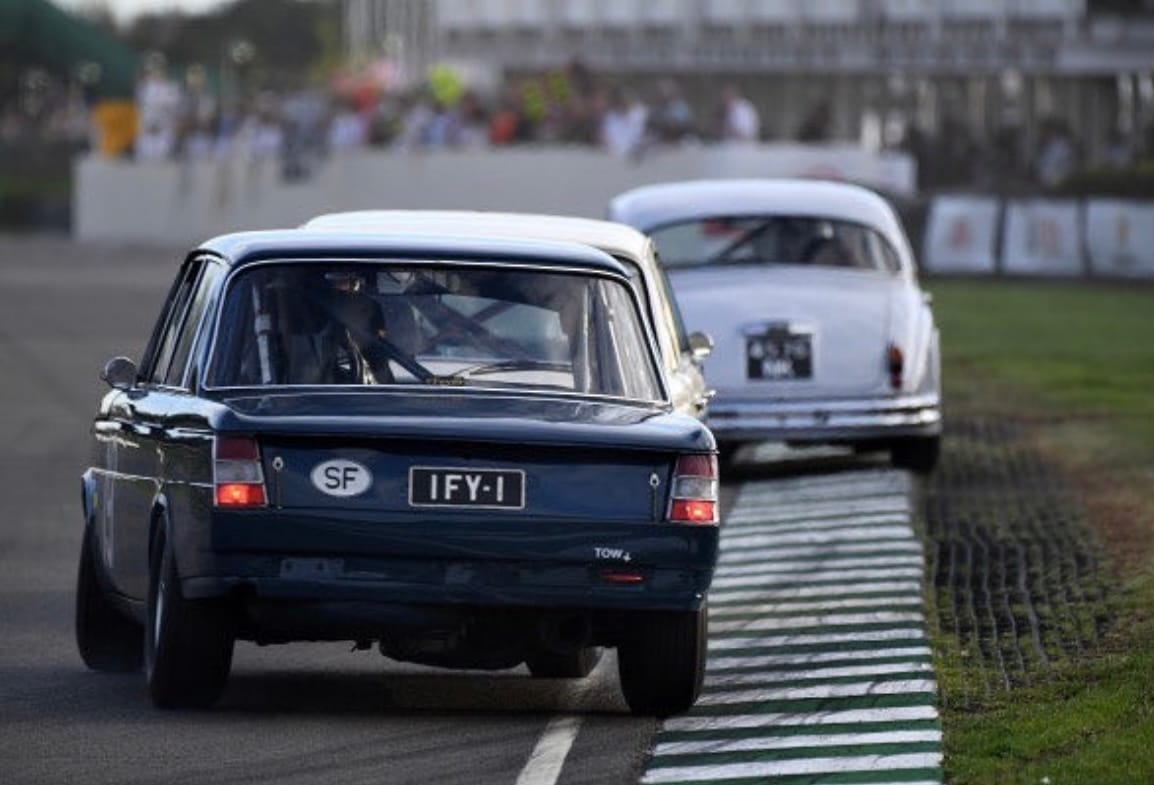
How did she get on?
She got on well, she took it very seriously actually. She's quite funny, my son's done it for a couple of years and she's done it, that's her second year, it's a loaned car which a very kind family let our kids do it. They're almost pro drivers really, racing someone, but she was quite funny. She was particular about who takes them out because you've got to set the wheels right. When they go and start up, so she was just checking that. I think my wife did one and she's like, can you do the wheels right? She got quite serious, but bless her, she did quite well. It was great fun, it's very serious actually, the cup because the regulations are quite serious, they scrutineer them and they measure the cars and the distance between the pedals and things like that. So actually the drivers briefings, even more for them than the main thing, so it's quite funny really, it's very sweet.
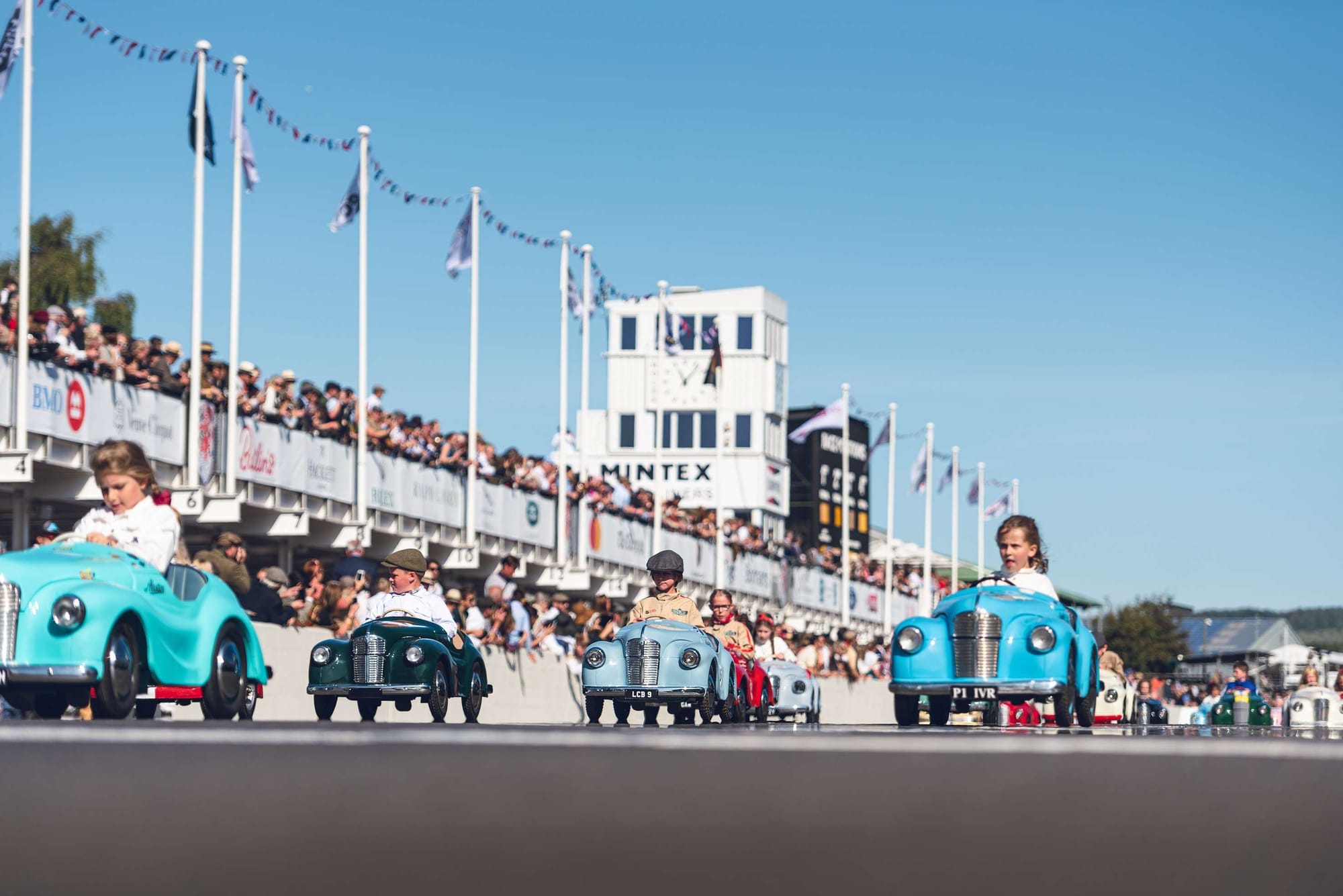
At Goodwood you also had your art on display as well. I was having a look around it, as were lots of other people, and it seemed to me you've got two distinct styles, pop art and then super realism, is that how you would describe it?
I probably have about three different styles actually. I've always done the more realist thing, but obviously that's developed over years. I've been painting properly since 1995. I won a competition run by the British Racing Drivers Club in 1995. It was for artists aged under 23 and I was 13 when I won it, and exhibited at the Old Coys Festival at Silverstone, which is now Silverstone Classic, or whatever it's called now, The Classic. So that kick started my career, and I always painted in that style albeit it was a bit more crude. I have developed that over the years so I've always done that. I now do half and half, I do a pop art style, which again I've been doing for 20 years now. That time seems to whiz by, and that's the style which I experimented with at school. I studied futurism and pop art and things, and it's developed from there really. I did a Christmas card for Fiskens, then I got a commission from someone else. I think Gregor said it at the time, he's like have you done anything a bit different? And I was like, well, I have actually. I'll give that a go, but I did it at school, I was like I'll do that again. It was quite a cool picture, and then did another, and then that got featured in lots of magazines and things and newspapers. That kick started that style. That's quite a mix of quite a lot of different things.
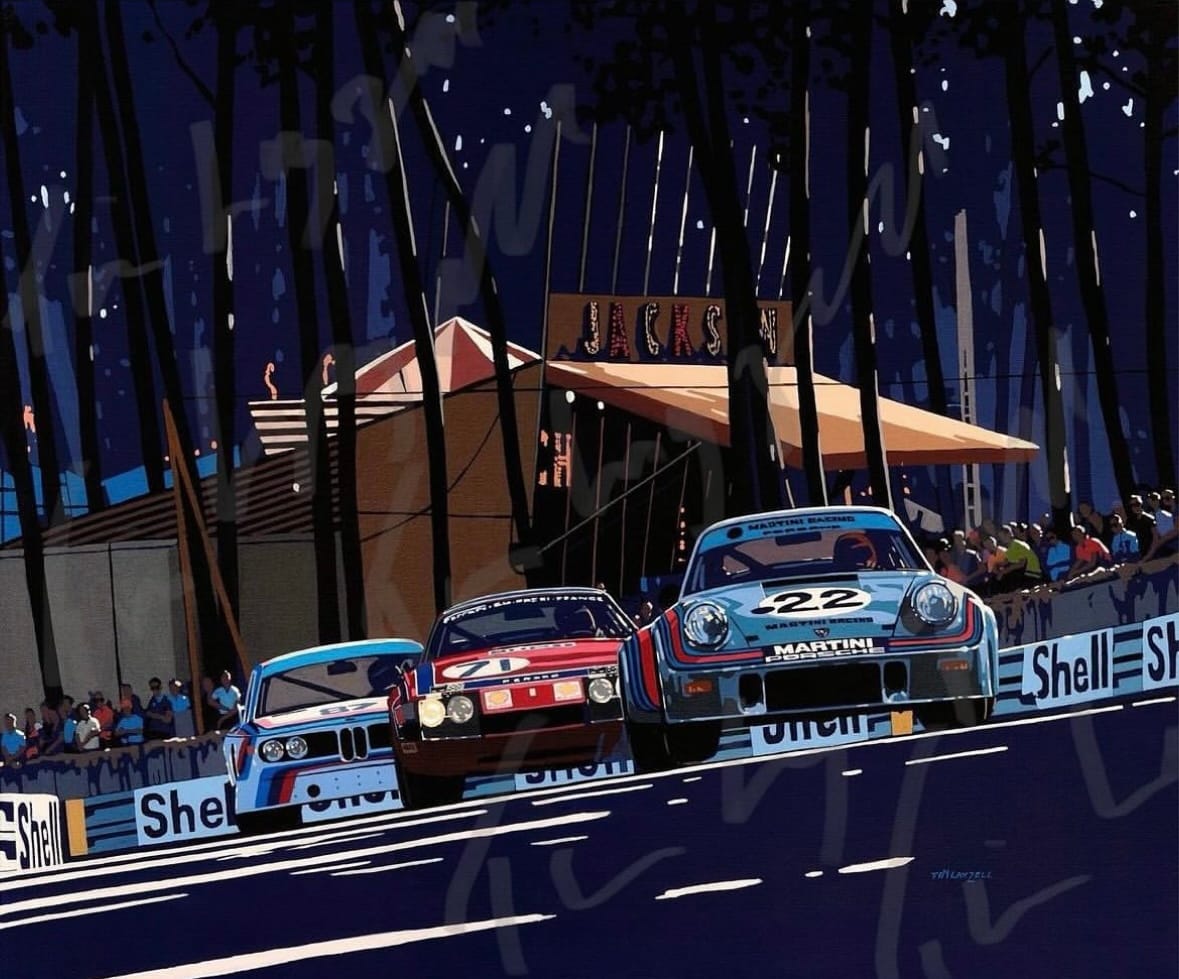
My wife, she's a medical student, and when she was living in her student house with her friends, they were all experimented with painting pop art pictures, and one of the bars we used to go to, used to have the Liechtenstein paintings with the fighter planes the power kind of thing, so I was hang on a minute, I could do that with cars. Then I also liked George Ham, which is pre-war Monaco posters and things like that. Then I quite liked the railway art of the 1950s, so I kind of culminated everything together, and I thought well, that would be really cool if I could generate speed, but in a really simple style. That's kind of where this kind of style has led to. This is the ultimate development of it, whereby there is a bit more detail these days. When I started it, it was much more basic. I try and pair everything down as much as possible and put as least detail – the least detail, the better in a way. But that is quite hard to do. So it's more a case of what do you take out? Because obviously I can do the realist style where I put loads in, loads of details, this is more a case of, what can I leave out but still retain the speed and also the detail? I think what a lot of people like is the shapes of the cars, obviously you've got to get that right, but not only that, you've got to get the handling characteristics right, so the lean on the wheels, the angles, is it braking, is it accelerating, is it drifting or is it just doing four wheel drift? I think that's really important to get that right, and that's obviously what I spend a lot of time doing. And although they look simple, they actually take longer than …

… they don't look that simple.
They have that more simplistic look, but compared to say this one which is a realist, that's lots of, I would say just dots and dabs and bits and bobs. They do take around the same time, but this is quite a stressful thing because you are trying to make it simple and it has to be really neat. So until it ends up neat, it can look quite crap, for want of a better phrase. That creates quite a tension because you're like oh, is that going to work?
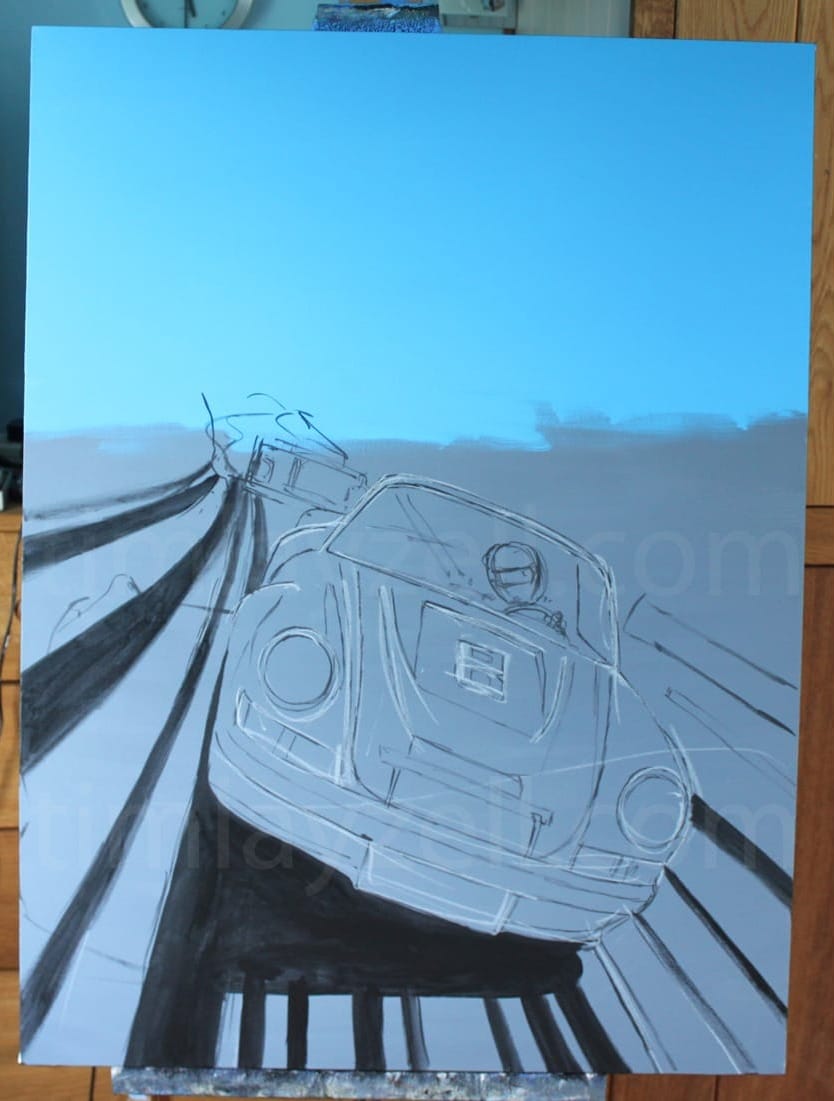
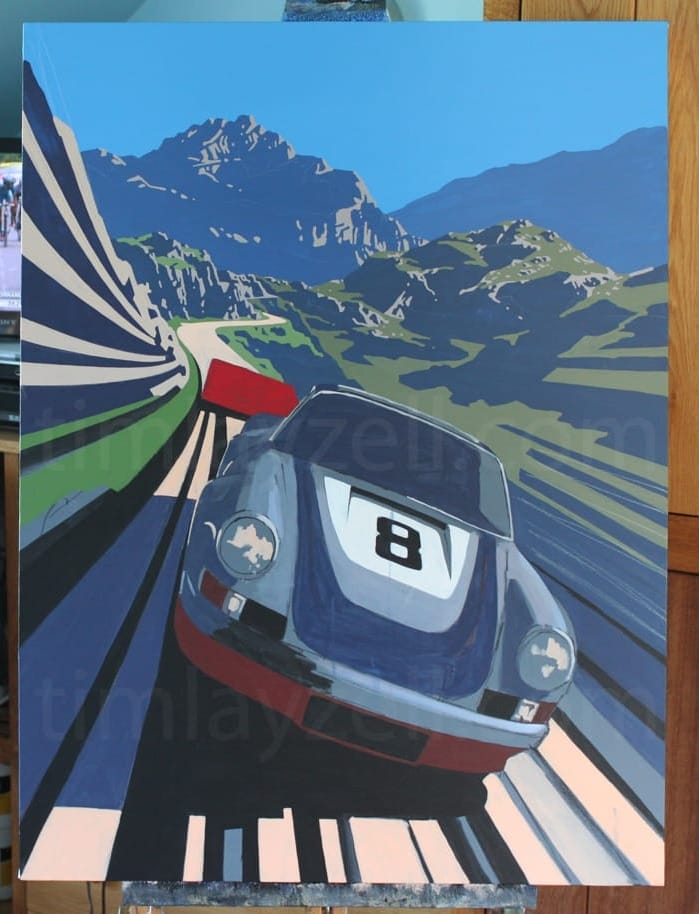

Source: Tim Layzell
You have to be committed to it.

It's an exciting style because you can play around quite a lot with it. And obviously with this one particularly, I've bled the lights out behind the car and things like that, and you can really go a bit more interested with colour. The temptation is to go back into detail. Obviously this is a poster for Pebble Beach, so they like having the event in the background, and that is coming down to the show field. The hill wasn't quite that steep, let's say, but obviously you're trying to convey, it's a poster at the end of the day, so you're trying to convey that kind of thing. The cool thing about that one actually, for a start the cars are amazing, you've got the Lancia Stratos Zero, and then the Aston Martin Bulldog. The Zero is 50 years old, that car is 1970, and still looks quite modern. It's quite strange. The Bulldog, they're both revolutionary really space-age kind of cars. Obviously it looks 70s, but in a way it almost hasn't aged in a funny kind of way, it's still fresh. You see it and you go wow, really cool, the rear lights and things and the wheels, a very cool car. I think what's quite cool about that particular poster for Pebble, is that for them, Pebble Beach, they have everything from 20s kind of cars, and there's been a core of 50s and 60s cars, and I feel like they're trying to go a bit more modern now, which is exciting. I think where the whole classic car thing is moving, to the 90s and things, so they had the BPR cars, the McLaren F1s, XJ220s and things, so that's kind of a nod to the fact that the future is arriving at Pebble Beach if you like. I haven't got the McLaren F1s and things in there, but I think everyone can kind of feel that kind of changing a little bit and everything is moving a bit more 70s, 80s, 90s. I love 50s and 60s cars but there's definitely a momentum there I think to move forward a bit. I think they're sensing that and there was a bit of a leap of faith, which is really exciting and I think it's really successful.

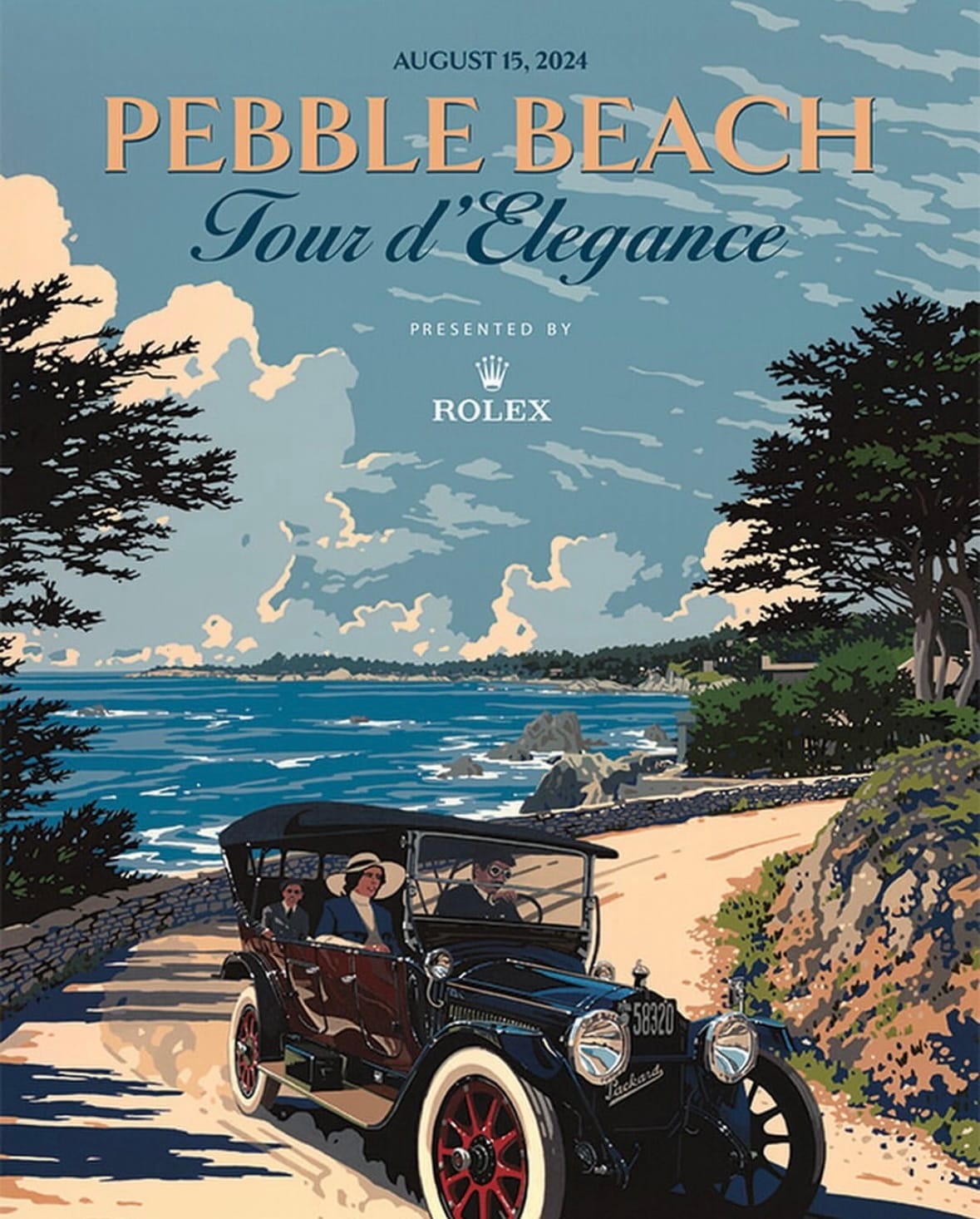
Source: Tim Layzell
I was just looking at the some of these pictures, and I dabble a little in photography, and obviously you have the rule of thirds, is that something that applies to your art, because if I was to imagine the rule of thirds on that painting, you have the cars on that bottom line, is that something you think about?
I don't really like having anything too central. The slightly complicated thing with painting something like that is that the original painting is there, obviously I have to make room for the script to go above. So there the spacing of that painting is slightly different to some of the others. The GTO is right in the bottom third probably, and I quite like having that sparse space. If I was braver I would probably leave even more space. Again, it's about what you strip down and things like that. There's certain tricks of the trade I use for different paintings, again, in the realistic style. I tend to have a shadow along the bottom and that's to make you feel like you are looking into it. So that creates a feeling of depth because ultimately it's a flat canvas, so all the time you're trying to create a depth. Obviously the hills and things get paler and paler as they go back, which we all notice hopefully as we go for a walk or something like that. There's all those kind of things that I use. Essentially I am self-taught really, I painted at school and my school hated me doing cars. I was always into cars as a kid. My dad always had TVRs, I've had quite a few TVRs as a result, but we used to go and watch lots of vintage sports car club events from little and then I'd come back and draw Bugattis and things like that.

So he helped me early on with the painting and stuff, but at school I did paint cars but obviously as you can see I paint loads of other stuff, I paint people and landscapes, predominantly things like that, that painting they are a landscape with a car in it, so for me that's really important to create a picture. So in a way I never really got the fact they didn't like me painting cars because they're really hard as well actually. They are hard if you want to make them look real and look like they're moving in a certain way, and that's why I've built up over 30 years really, suspension movements and stuff like that. My art teachers were not interested in me. I may have been a muppet at school, I was frustrating probably to teach at school, I didn't particularly get on with the whole experience, but I did like doing cars and when I left school after A levels I just started doing it as a full-time job. Because I had already started, as I say, at age 13, so I was doing it. When people were doing their GCSE research, I remember I had my first exhibition at Goodwood Festival of Speed, I think when I was 15. I was still a year before GCSEs, and I remember finishing school and then trying to get some stuff finished to have an exhibition. So it was always that challenge, but I am essentially self-taught. So all the things I'm talking about, maybe they would have taught me at art school, I don't know, but I've picked it up.
It's quite impressive. I love the fact that it is self-taught and it's not 'follow these rules and you get this result'.
Well it might have been easier. There's two ways you can think of it, you could say well then I might have been a bit more generic, but then it might have short cut to things that's taken me years to realise. Nowadays I guess you've got YouTube and you could probably just YouTube it and just say well how do I do that? Most of the time when you're at the easel, it's problem solving, you're kind of like, how should I do that? Sometimes when I'm on a mega deadline, I work really quickly, and it just speeds up your decisions, and that's ultimately what it is, because you're like, well I've got to try that. If I don't try it, I'm not going to get this done. So you just try stuff. If it doesn't work. The good thing with acrylic is that you can just paint over it, to a degree, obviously you can't slap the paint on because then you'll see it through, so you've got to be a bit tentative but ultimately you're trying stuff all the time and then you can, particularly with styles like that, you're kind of like how complex do I make the trees? I couldn't make them so complex that you couldn't then see the writing over the top and things like that, so you're always kind of, and then you don't want to detract from the car, it's all winging it a bit, to a degree. Obviously, I'm not really, winging it is wrong now. I don't ever throw a painting away now, but I don't really have any failed attempts, and I haven't for 15, 20 years, because I would spend a long time thinking about how I'm going to do it. I guess I've got a good recipe that know works. It's complicated within that experiment. You're obviously trying to experiment, but you don't want to experiment so much necessarily that it fails, if you haven't got time. That's the slightly complex thing. I have a really long waiting list, I have a 18 months to two year waiting list for commissions, which is amazing. I suppose that I don't experiment quite as much as I would if I didn't have any waiting list, you could go a bit more bonkers with it. It's a tricky balance that, because I know things are going to be seen again, they're going to be featured in magazines or books and things, so it's more that I'm going to see it, I know it's going to bug me when I know it's not right, so I work really hard to make sure it's right.

Everything I do, I would never turn anything out now in a wild rush and say right, that will do. Unfortunately people do have to wait because it's a creative, nowadays I haven't got a computer behind me saying we'll solve that problem behind a computer program. Still I think quite a lot of people think, I get asked what program do you use, and I'm like no, you don't understand, it's completely just from draft to, when I start something it is quite scrappy and then you just build it up and up. It's not like it's drawn out and then I fill it in, so it's really different. I think that's where people maybe, I don't know how other people view it, but if I see something like this computer generated, it's a bit like car design. You can see something that's been drawn on a computer compared to a 1950s, 60s Ferrari where it's been penned and made by hand because it's different to the one next to it. I think you can see that in a painting and I think we are at a crossroads in car design and well, it's gone over the crossroads of car design but certainly in paintings, where obviously there's a lot of stuff done on computers now, which is tidy, but no disrespect incidentally to people that do that. It's a skill that, I can't use a computer like that, but it's not organic in the same way, these are built up and you're just constantly moulding it. I think sometimes people that are maybe even collecting art and things like that are, I think some people really appreciate it but other people maybe if you're just doing it, you're kind of like, I quite like that picture, I quite like that picture, maybe you don't see the difference. They are like chalk and cheese, they are two very different things, if that make sense, I think that's quite a challenge going forward, to differentiate that. That's the thing with the style actually, is that quite a lot of people have used my style, which as some people say, is quite flattering, but it's quite frustrating as well, especially if people don't think it's my style, but it's not, it's well no, I wouldn't have done it like that. I can see it but maybe if you were casually looking at it you might not see it.
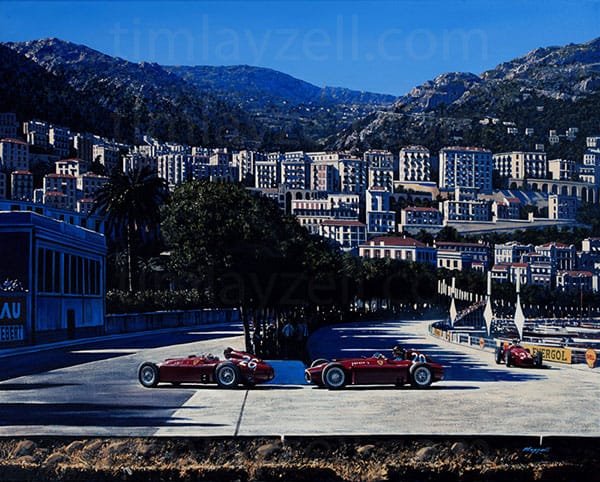
Yes, I can see imitation is the best form of flattery, but I can see the downsides of that as well. I suppose the process as well behind going about painting something like that, you don't just get the canvas and start putting the paint on, how does that process work?
It differs depending on what kind of picture it is. If it's something like the Pebble Beach posters, they come to me with the cars that they are featuring at the event, then we talk to the owners and then we go through some ideas. I then come up with some draft drawings and then we go from there. I usually do quite a few different options. Sometimes something really leaps out and I might do one, then I've looked at quite a lot of different angles and this that and the other, but I'm pretty sure that is what we want to do. So sometimes you nail it, sometimes you kind of think well actually, we could do that, we can move it here, we can move it there. These ones are a bit more planned out, these are more realist style ones, while if I'm doing something for an exhibition and I'm just painting something to sell, I don't generally do so many preliminary sketches or anything like that, I kind of do just go for it a bit more. So it's quite different but if someone commissions something, then generally I research it endlessly, which is where a lot of time goes actually. Loads of different angles of the car, I might go to see the car sometimes or people might send me the photographs, but it's generally better if I can go and see the car. Note to self: if anyone wants their racing car painted, it's better if I race it first.
Of course.
I really need to be more demanding. Then I do sketches and then I go from there and then it just goes to canvas. But even then it can change a bit, where I say well actually we can, these lines are moving all the time. I might have started further over and then I'm actually it's going to look better if we do that. It's a constantly moving process, which oddly, and I've still not come to the answer to this, one of our friends was saying why is it a painting and not painted, but I presume that is because it's constantly evolving and it's never really finished kind of thing. I don't know, maybe that's it, someone else may have the answer for that, but that's my interpretation.
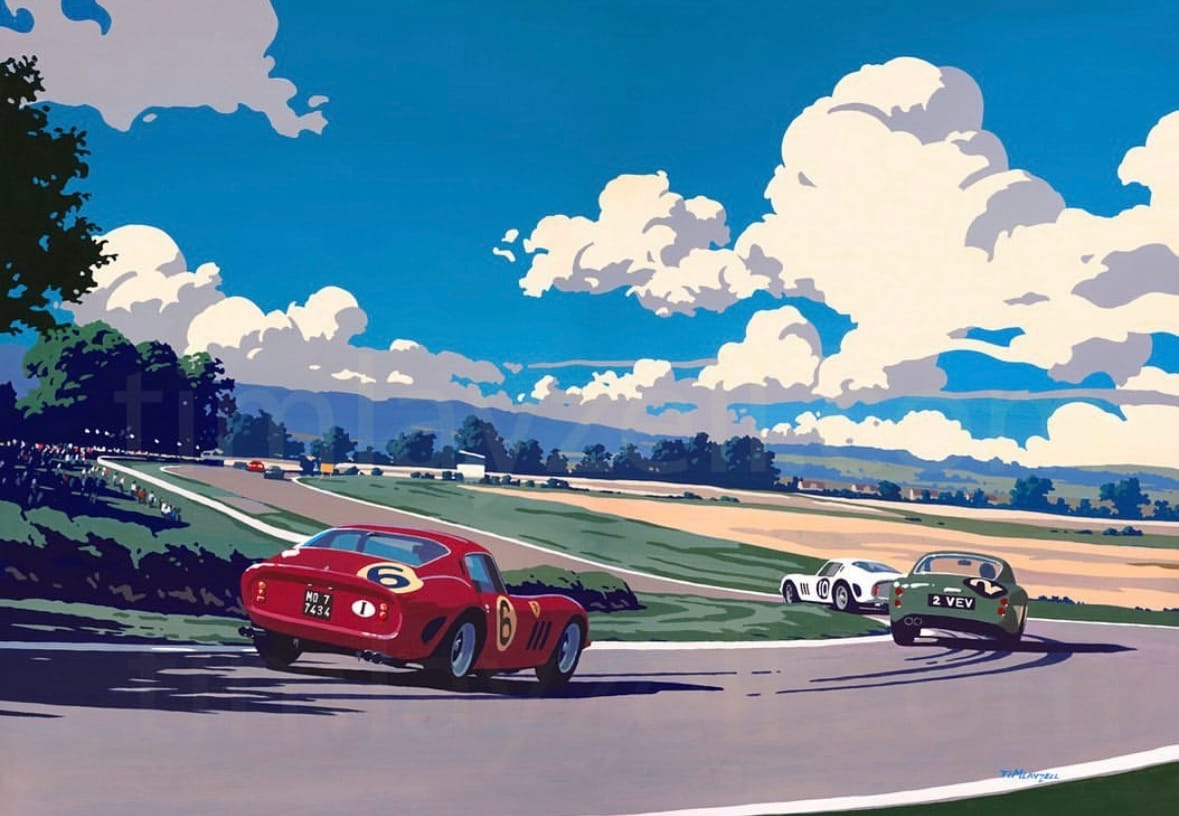
I suppose it's quite tricky as well, you're doing really old historical stuff, the deep dive that's required, actually finding the information, the library of books you must have and the photos.
I've got a lot of books and I've just built up loads of saved images over the years, just researching, because ultimately historical accuracy is really important for me. Again it is slightly different at the Pebble Beach stuff, but most of my work is motorsport art, say Targa Florio in the early 60s. Obviously most of the material is black and white, for a start, so a lot of research needs to go into the colour. You get quite good at interpreting what colour that probably was, just from the tone and things, but then if you can find colour, then it's like gold dust. But that's essentially what I'm doing. Especially with painters like the GTO one, that image does not exist until I've painted it. I'm not painting something that already exists, I'm creating a new image. Sometimes you get photographers featured from the 50s and 60s where they've discovered new collections and things, and that's kind of what I try and do, is just produce something that nobody has ever seen before, of a famous race or a famous car, but then bring colour to it, which again, there won't be much of. That's really exciting when you see a colour 1950s photograph or 60s photograph, because you're like, wow, I haven't seen that before. That's kind of what I try and do. Obviously in the light that I use, I don't ever paint really neutral light, I really like dramatic shadows and brightness and depth. Well for a start it creates depth, but also people want warmth really on their wall. I do paint wet racing scenes and things, because that is cool, but people like to be happy. We are all happier on a day with a blue sky, and a lot of people like my blue skies and I just kind of think, well yes, that's what you want. You want to be there, you want to be happy, so I kind of do that.
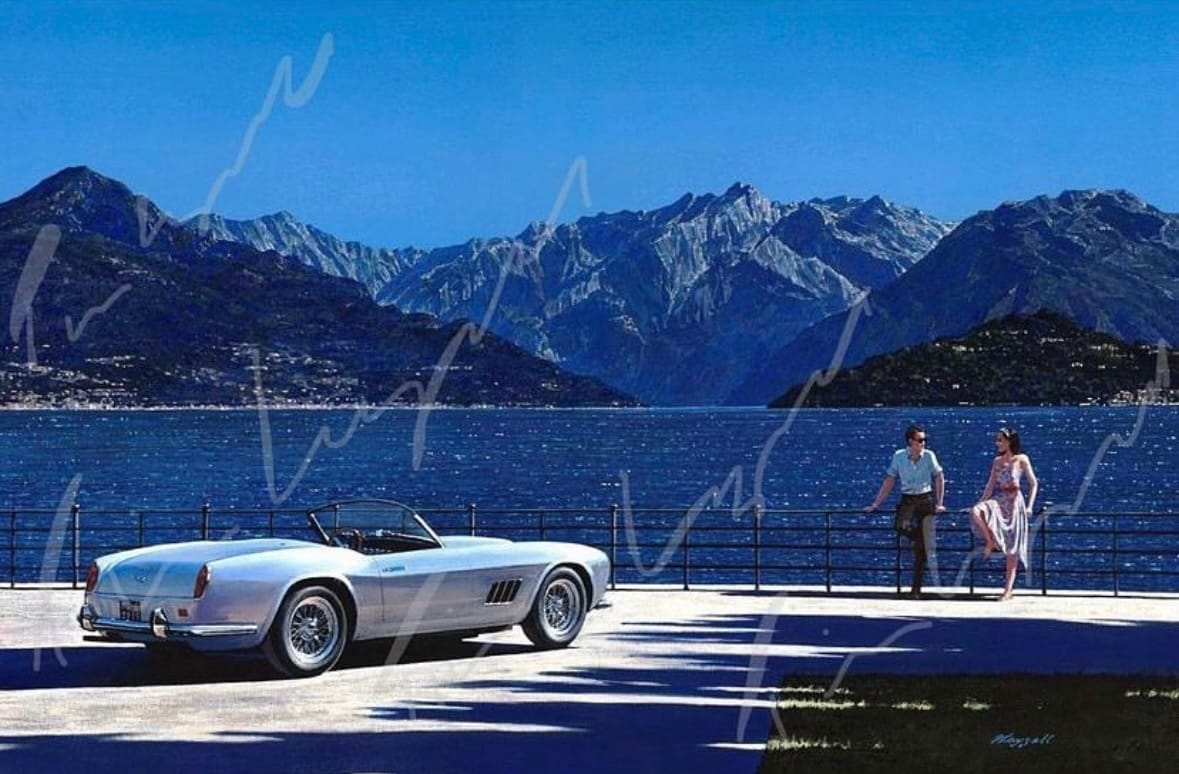
How long does a painting take? You mentioned earlier that even both styles are quite similar time frame, what is that?
It really depends where you draw the line really, just the research can take ages. I have a long waiting list, but even at the start of the waiting list, people put their name down, I'll start researching it quite early, and then just gradually build that up and up to the sketches. I am very lucky people are patient with me. That in itself is complex. I am a one man band, I can't farm that out. Obviously Damien Hirst and people do, but it's not like, I think people sometimes forget that as well.
It's not a mechanical process.
It's not a mechanical process, people obviously get frustrated waiting for cars to be restored, but they can take ages because ultimately that is a bit of an art form sometimes, but this really is an art form, in the truest sense. I don't work like your typical artist, in that I get up really early, so I wake up at five probably and then start painting. It's not unusual for me to be painting by five or half five in the morning, so I do work really hard. Coming up to exhibitions I'll be working until 3 AM in the morning and then starting again at six, so I will do a lot of hours when I need to, but obviously you can't sustain that all the time, otherwise I would be dead quite quickly I think. It's complicated with kids, because I like walking my kids to school and things like that. And also just when you're working on your own, I need to exercise a lot, otherwise you just go mad. I cycle and I run, I surf if I can. We go to Cornwall a lot so surf. So you need a certain amount of time out to be able to achieve it. I don't want to do anyone else's job, you can sit in the chair and I can do it from start to finish sometimes, but it doesn't really work like that. Usually you do it over a few weeks and months sometimes, because I generally paint a bit on one picture and a bit on another.
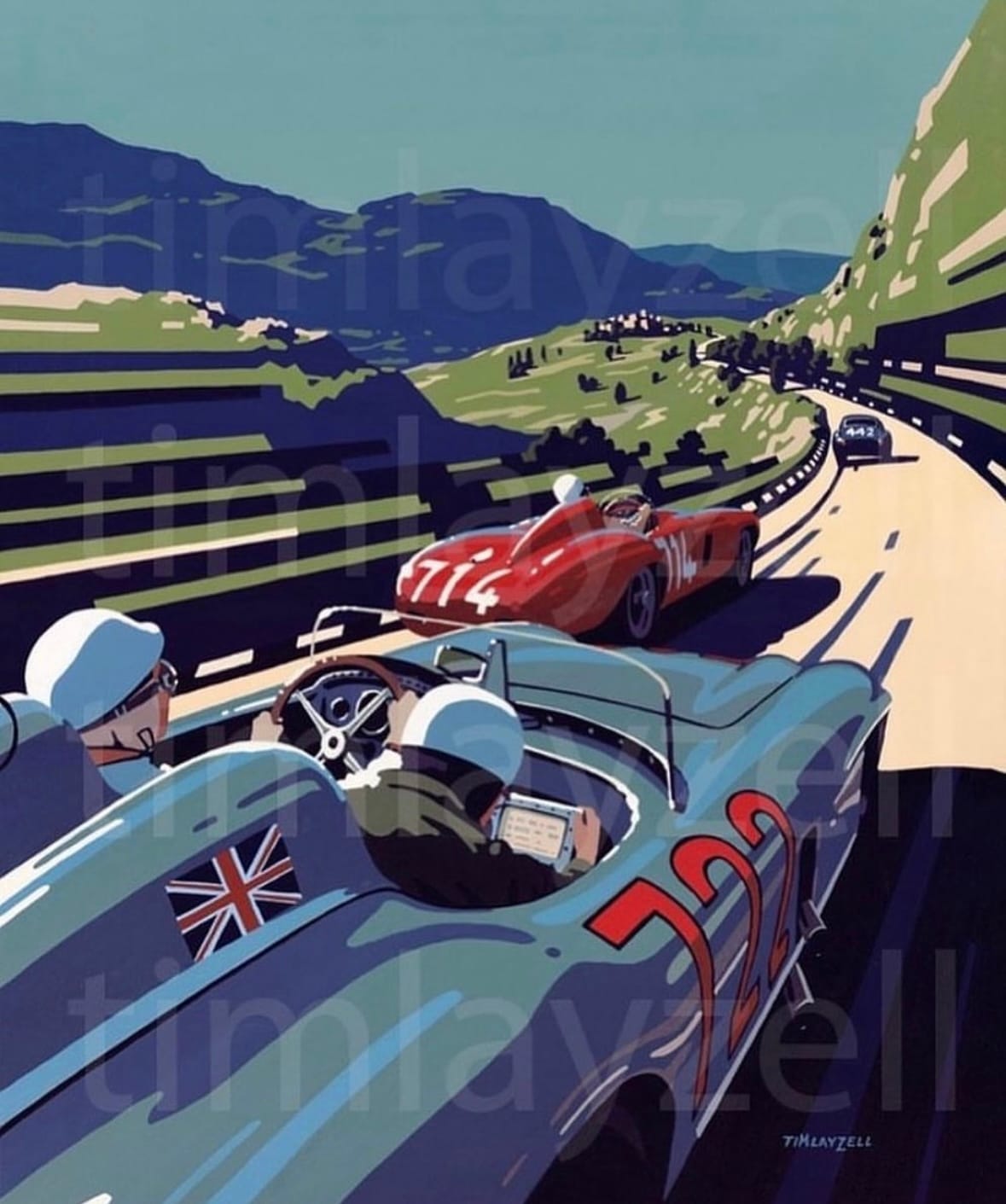
You dabble.
Yes, because like I say, you're learning all the time. So I'll go from style to style. I do pop art and then realist. I was just going to say with the style, in between that there's almost a poster art kind of thing that's slightly different, where it's almost in a poster style, but it doesn't have quite the same speed kind of thing. I should just say the principle of pop art and poster, the true difference is the fact that the colours in a pop art one or a poster one are not blended. So they're mixed, so you mix all the colours, but across the shades of the car, they are solid shades. They were on some of my first ones, but essentially the sky colour is one colour. Then if you want a break then I need a line between it. So with the car colour, fortunately there's loads of lines on that car, so quite crisp lines so it breaks it up, but essentially none of this shadow is getting lighter towards the top. That is a block colour, whereas obviously on the realist style, it goes everywhere. So you've got loads of different shades and you can blend it. That's why you have to be really selective with style, and that's what's time consuming. Even just that orange, I might have nine different colours in that colour, mixed up, and then a varying different blend. I might do it, and of course with acrylic on canvas. in oil I don't think that would be possible, that style, because it would just take too long to dry, and then you would be smudging it all the time. They dry really quickly in acrylic, otherwise it would take you just so long to do. They dry lighter than they do when they are mixed. So when they are mixed they are much lighter, so you have to predict where the colour is going to end up. Once I've mixed the cars, I keep them potted up actually, they last sometimes a couple of months.
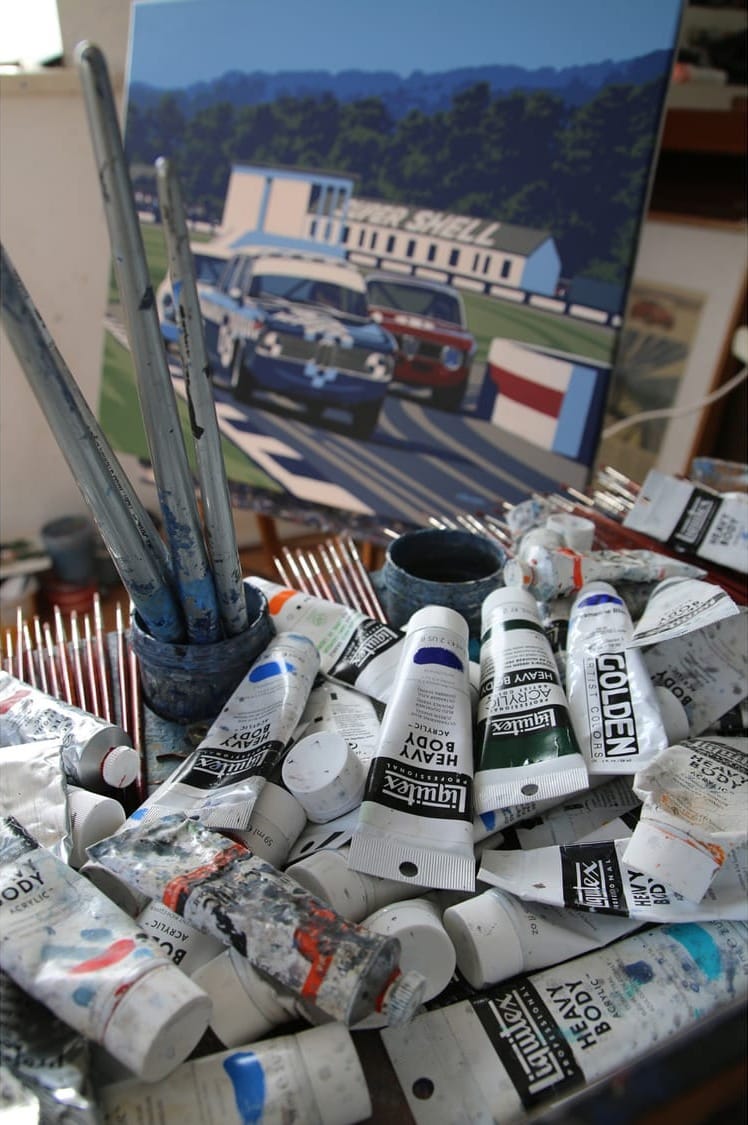
Who are your artistic inspirations?
Some of the names I've mentioned. When I started out with the cars, Michael Turner, he used to do a lot of race scenes from the 50s, 60s, 70s, and he was more a realist style. Then various others like Dexter Brown who really abstract, almost a bit impressionist I suppose. Barry Rowe, sadly passed away now, he used to do the Pebble Beach posters actually quite a lot, and he was quite into light and shades, so he would do the really yellowy colouring, and I got into a little bit of colouring of that early on. Then just the impressionist really. My realist style actually is just dots, it's dots and dabs. So if you are up close to it, people think it's really precise. It is to a degree, but it is quite dotty. So it is impressionism to a degree, not in its truest form, obviously impressionism is a bit more abstract, but it is in a way. Monet and Pissarro were quite an inspiration, mainly for light and shade. I'm always pointing out to the kids when we're out for a walk, look at the colours in a shadow under a tree. There's loads of blues in there and things like that, they're like well how's that possible, it's on grass? It's reflecting the sky, you might not see it from first view, but actually the more you look around you see all the colours, and once you've seen that you just keep expanding that. Ultimately that's what painting is, it's an expression of, it's a simplification of that, that's what the impressionists were really, they're a simplification of what you actually see, rather than what you think you see. A lot of people say, have you got any advice on painting? I say the first rule of thumb is draw what you actually see and not what you think you see. Especially for kids, drawing when they're starting out, even adults, if you're drawing something, people say I'm going to put a wheel there and put a wheel there and then draw a body, but actually it doesn't work like that. That's the first discipline really of painting.

Did you speak to Daniel Arsham when you were at Revival by any chance, he is a visual artist, I don't know if you're familiar with him? He did the livery on that Porsche 904 Ikuzawa, have you ever thought about doing an art car?
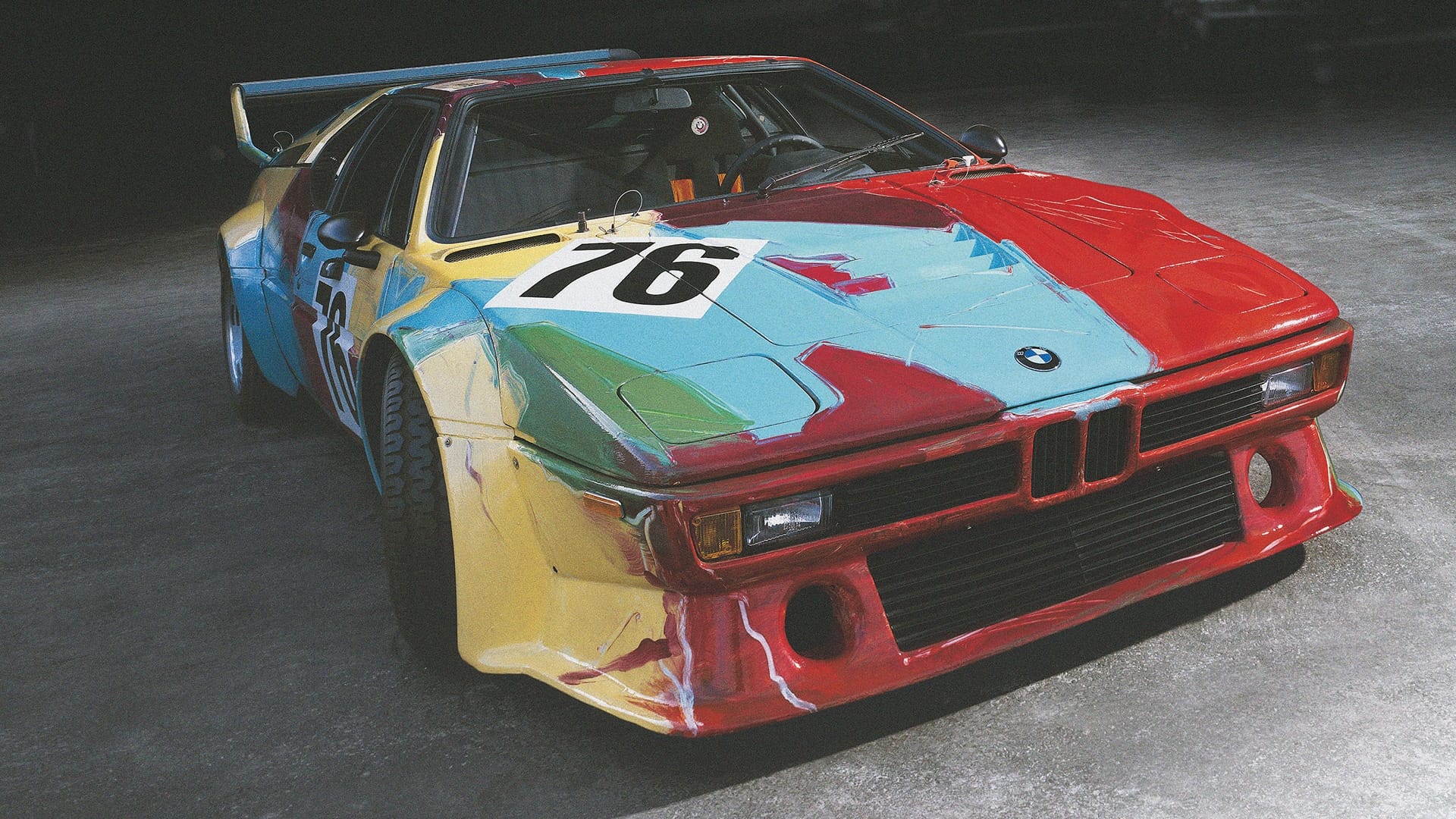
I have thought about doing it. Quite a few people have asked me, and for whatever reason I've just not gone around to doing it. I did kind of think oh, should I paint my own car and race it at the Revival and race it as an art car, that might be quite cool, but I haven't done it yet. I paint all my own numbers on, so my race numbers and roundels and things are all painted on. I haven't got as far as doing the whole thing. I'm a big believer in painting your numbers on. I always get frustrated, not to go off on a tangent too much, but I get frustrated by really nice cars, and I mean really nice cars like multi-million pound Ferraris and whatever else, then they've just got stickered numbers on and you just think, don't do that. It can look so much better, like the Mille Miglia, when they used to paint the numbers on. Those guys were obviously talented, but they were obviously doing a lot, so they kind of got into the swing of it, but they were fantastic. But that just looked so much better. I always paint numbers on the car because I just think it looks so much cooler, than just a sticker which you might have stuck on a Vauxhall Nova. I think if you've got a multi-million pound car and you've done that, it seems a bit strange.

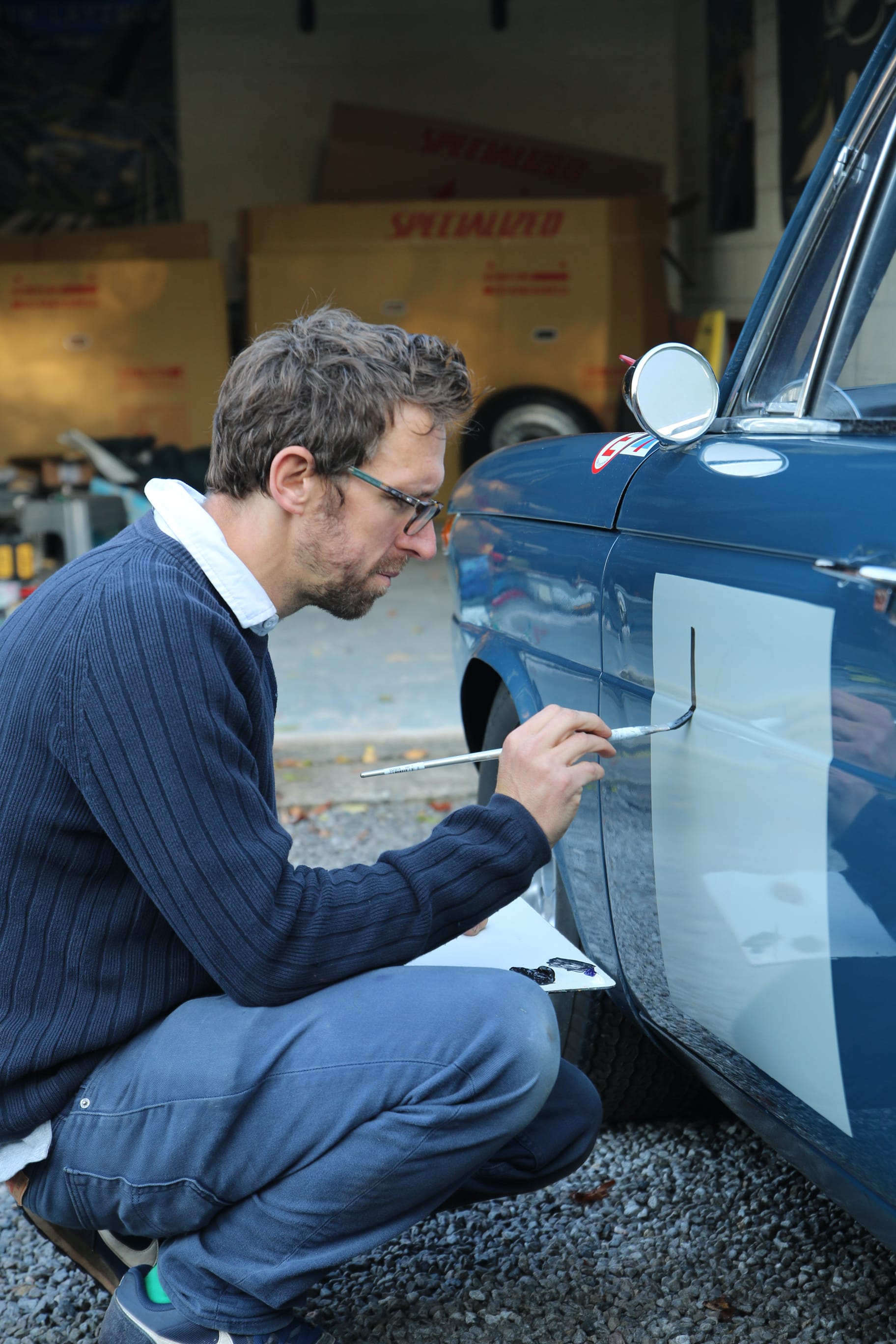
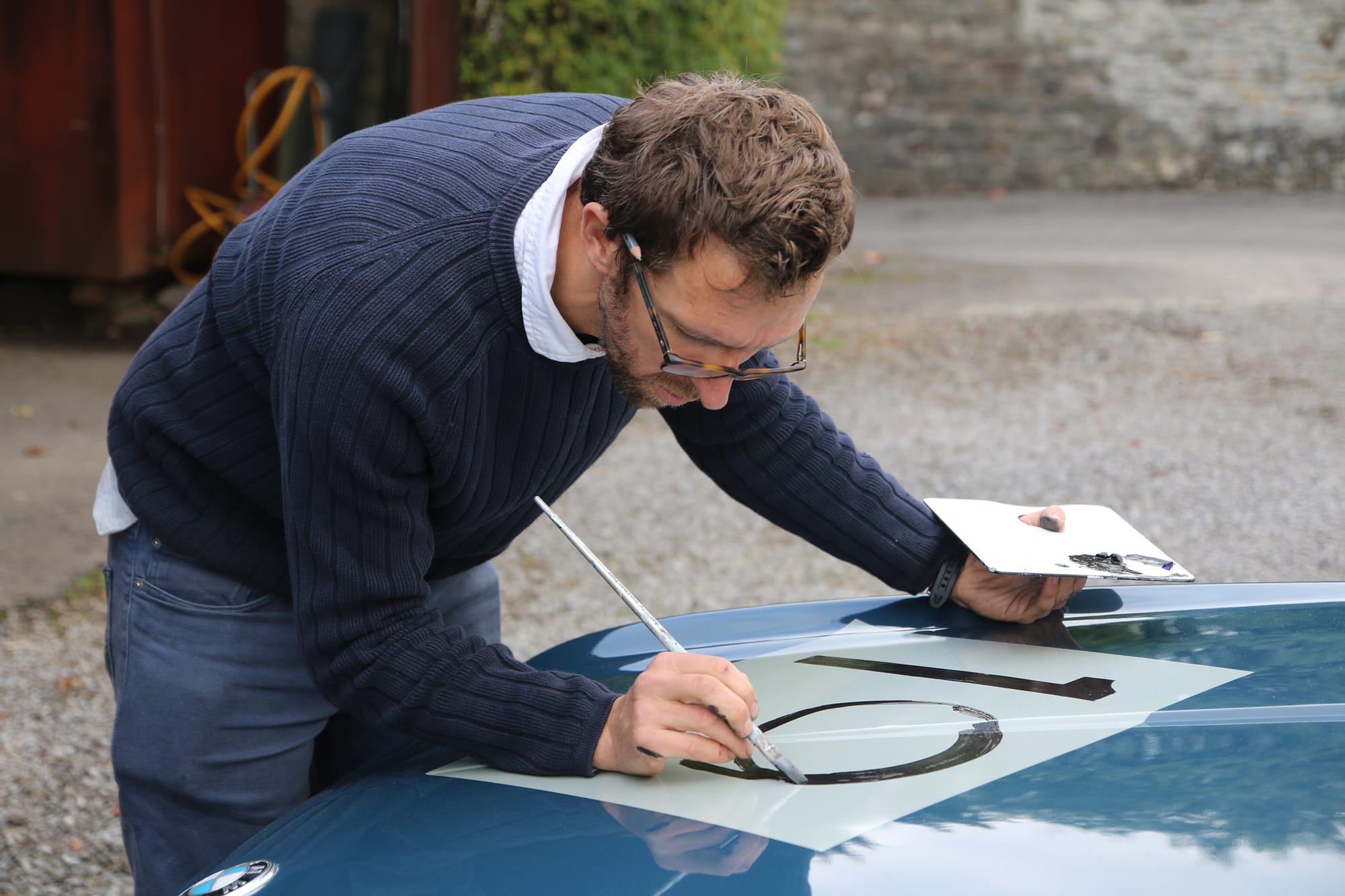
Talking of race cars, you have raced quite a bit as well, was it TVRs?

I was racing a TVR Grantura and I've raced that quite a few times at Goodwood over the last few years. Sadly I have sold that now, stupidly, I shouldn't have sold that. I try not to think about that, but that was a really cool car. That I had raced quite a bit at Goodwood in period, and then Nürburgring and Spa. To be honest, it had done so many races in period. Really impressive, Silverstone, Six Hours and things. I bought it and we raced it quite a few times. We did the Speed Week in lock down, which was actually, I was talking about it with a friend recently, he also raced there that week, and strangely I was going to annoy the spectators, but that was one of the best race meetings we've ever been to. Obviously there were no spectators because it was in lock down essentially, or just out of lock down, a semi lock down, whatever it was, and the event couldn't have any one there. I guess it probably made a difference that we had been locked up essentially for a long time, and it was the first time you were seeing people. But it was just incredible. You were there and you were pinching yourself that we were at Goodwood and we were racing. Obviously everyone had to keep the distance and they managed that really well, but it was just incredible. I did two races that weekend. and we shared the BMW with Marino Franchitti. Then I shared the TVR with Richard Meaden, Dickie Meaden. I think we finished 10th or 11th, this is the Moss Trophy, and it's really poignant because Sterling had died not long before, so it was a tribute race to him. That was quite amazing because I had met him a lot, and I painted him obviously a lot over the years, and I'd met him many times. So that was really amazing to be in that race anyway. But we were in the little TVR, which is only an 1800 engine, obviously a bit lighter, but we were in against all the Ferrari short wheelbases, E-types, DB4 GTs, so fast stuff, and I think we finished 10th or 11th, which is pretty impressive against all the E-types things. We beat a lot of heavy, big machinery sort of thing.
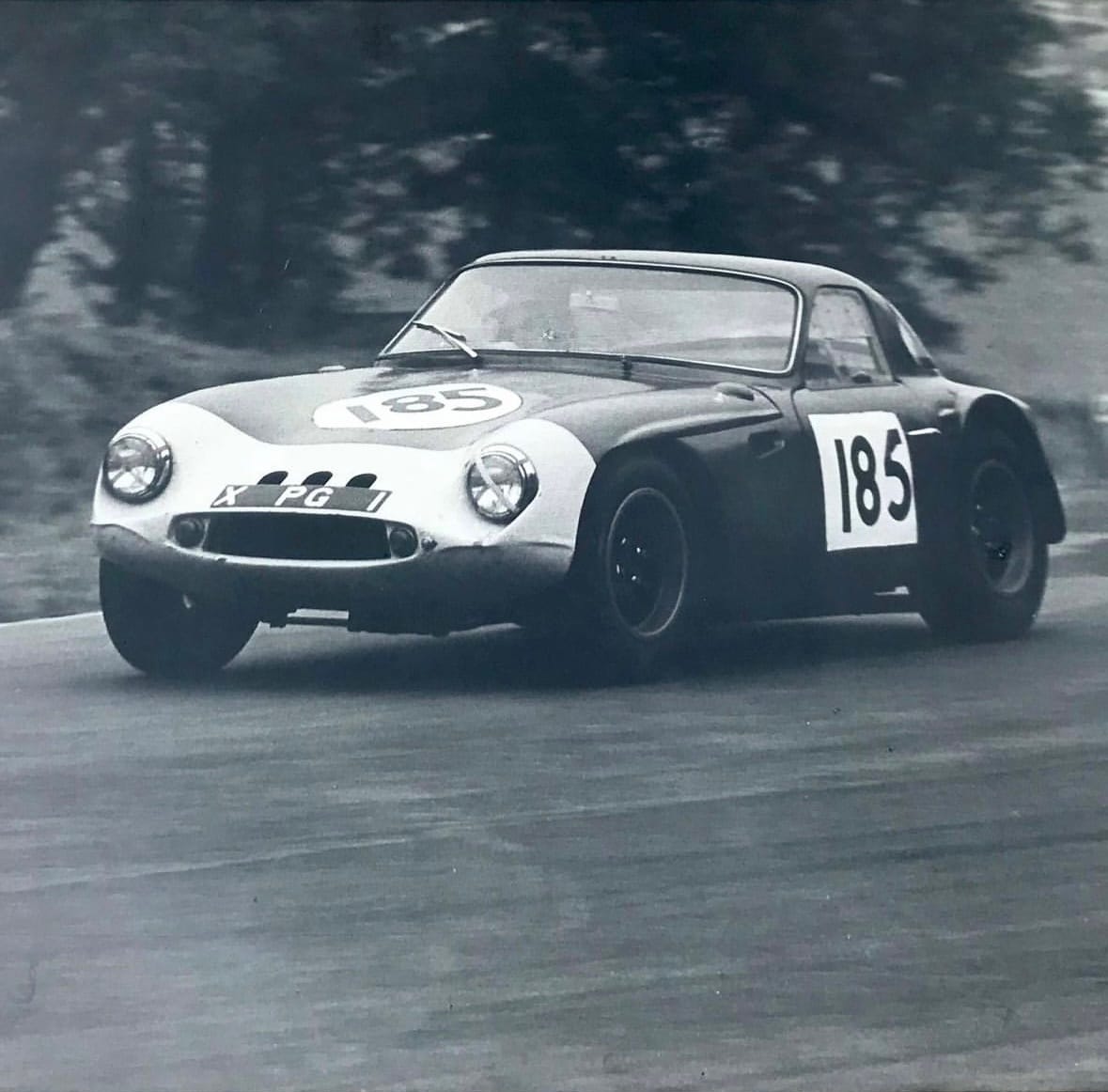
To finish up I was going to ask you some quick fire questions. I feel like this one is going to be like choosing your children, but what's your favourite painting that you have done?
That is a complicated one. I did a really cool one of two Ferrari Formula One cars coming onto the seafront in Monaco years ago, it's called State of the Nations. There's a really nice chap called Mark who owns it in Devon, and he's got a few paintings. I've told him before that's one of my favourite paintings. I don't know why, it's Mike Hawthorne and I think Luigi Musso, they're coming out of a bit of a power drift. It's in the realist style actually, but I just quite like the light across the bay because it looks across the Bay of Monaco, South of France, and the light's quite cool on it. Going back to inspiration, I really like Edward Hopper. all the light and shade of him. Various different pop art ones. Like I say, I don't really paint anything that I wouldn't like any more. I might when I was a teenager. It's funny, I know I'm supposed to do a quick fire answer, but people say to me what's it like selling it, do you get really sad selling it? I'm like well, that is my job, and it's been my job, I only had one job after I left school, I had a job at Gap clothing company, folding clothes, so I'm really good at folding clothes. But I was only working there for two months, then I'd be doing sketches. I was near the changing rooms and I'd do some sketches or some press ups and stuff, well there was no one there. Then I got the sack in the end, well I kind of got the sack, we parted ways, because they were always like you've got to help people more. I said I'll ask them if they want help, I'm not going to do any more than that. So other than that for two months, painting has been my only job. Obviously everything I paint, I paint to sell. There are some things I would like on my wall, and if they came back that's really cool to have on the wall, but ultimately that is my job, so I have to sell them really.
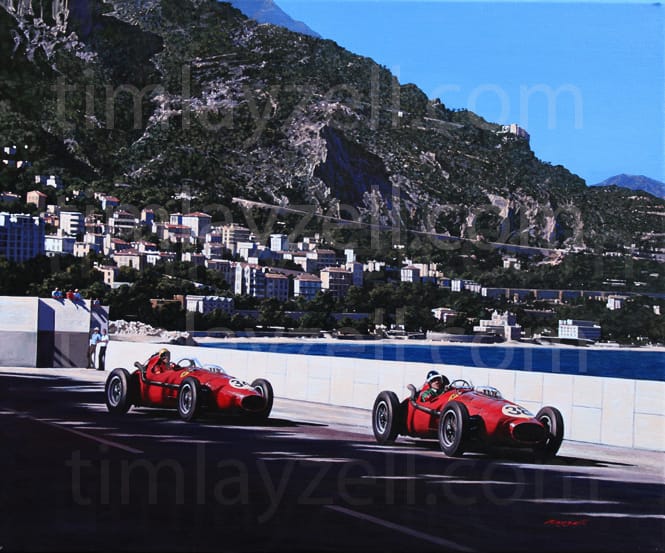
If you could only paint cars from one automotive manufacturer, which marque would you would you go for?

This is complicated because obviously I have done things for manufacturers. They are all great cars. I do paint quite a lot of Porsches, just because there are so many people who love Porsches. Their race history is really cool, certainly from the mid to late sixties through seventies and eighties, and their liveries are quite cool as well. I started out really liking pre-war stuff, Bugattis and ERAs and things like that, then I got into fifties, like Maserati 250Fs. I suppose ultimately Ferraris really. I just love 1950s, 60s and 70s Ferraris. I usually end up painting more sports and GT cars. I don't know why that is. I guess that's because I like the shapes, maybe. It also goes with drivers. I really love painting Fangio, Jim Clark and people like that, Pedro Rodriguez in the Porsche 917 and stuff like that. Sometimes I'm led by that, although great races, and it's a slight cliché, this is a long answer your question. This is a complaint my kids have when they ask me a school question, they are like dad, we haven't got time, short answer or long answer. My son had homework yesterday, he's got to interview someone and ask them the meaning of life, and they were like don't ask Dad. A 250 GTO is amazing, not because it's worth the most money now, that's irrelevant to me, it's what they did in period, they were raced and crashed and smashed. If you look at the Tour de France, for example as a race, they raced and literally the fronts were hanging off the cars, there's nothing left of them, headlights hanging out. So for me, that's all I was talking about with the TVR, where it didn't have the original chassis, but that doesn't matter as long as it's traceable. That's more exciting than a low mileage unused vehicle to me, because it's got a story to it. It's been smashed, but that's cool, it was smashed by a really famous driver on a really famous race in the golden era of motor sport, what's cooler than that, who cares if it's original? If it's original and it's unused from new, what's cool about that other than the fact that it came out of the factory? That's just not exciting in the same way. I guess the stories behind all the pictures are what I find fascinating. So that's your long answer.

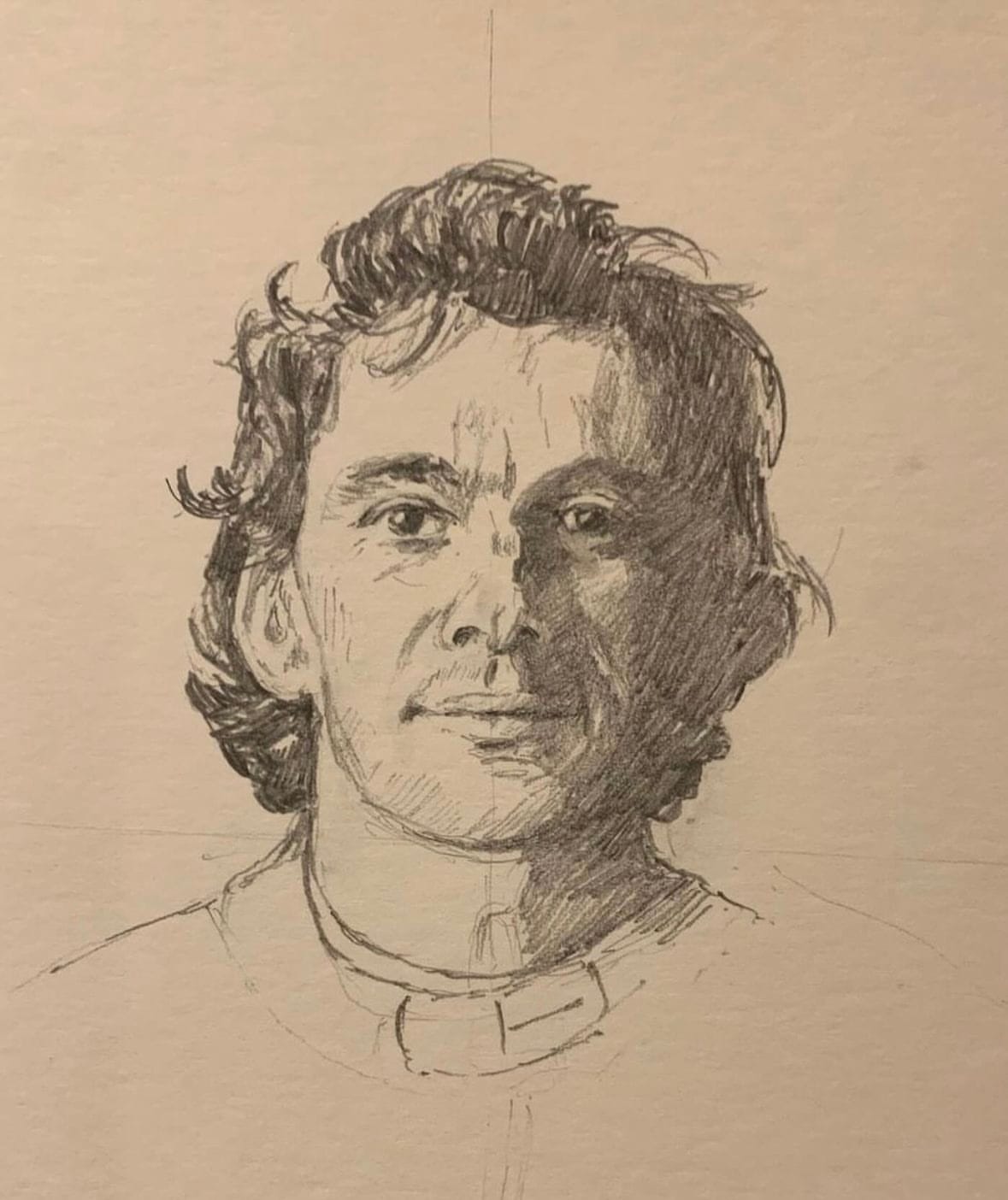
Final question, what is in your dream three-car garage?
My daily is a Transporter van. It's very cliché because I surf a lot and people say you've got it because you surf. Joking aside, I'm not sure I could cope without a van any more. I do surf and it is a cliché but it's a cliché because it works. You see people struggling to put a surfboard on top of a car. I cycle a lot so I take my bikes and stuff, and you just think people are struggling with a bike rack, and with a van you can just throw it in and you're away. I think money no object, I probably would have a Ferrari GTO 250, but it would definitely not stay in the garage. The unfortunate downside, the fact that it's so valuable, people just don't use them quite the same way. The coolest thing for me would be to have a GTO, drive it to the track, race it, hopefully don't smash it up too much and then drive it home and just use it all the time. I wouldn't want one and then you put it in a glass cage and then you just don't use it, because that for me that wouldn't appeal, so it would have to be something you use all the time and just don't worry about denting it, that would be really cool. So probably one of those on those conditions, so that people didn't mistakenly think I bought it just because it's expensive. I do like 50s sports cars, like a Maserati 300S or a Lister Jaguar, something like that or a D-type Jaguar. We used to drive up to Silverstone, the famous road through Chipping Norton and up through Burford on the way past Jeremy Clarkson's farm, Diddley Squat. Up through there, really amazing roads, and I used to dream of how cool would this be in a Maserati 300S or something like that, so I'd quite like something like that. Then excluding the van, it is technically a car but let's exclude the van because it doesn't really count, I think something pre-war, I used to have a vintage Riley which I used to do off-road trials on, but again, if you've never driven or been in a vintage car, obviously they're crazy but it feels like you're doing 100 when you're doing 20, so I'd quite like a Bugatti Type 51 or something like that. I am aware that obviously the van is technically the fourth car, but otherwise you are going to have to think of all the DIY jobs in a GTO, because everything else is not very practical.
Tim, thank you so much for taking the time. Where can people find out more?
My website, www.timlayzell.com or you can find me on Instagram, which I think I'm @timlayzell. I need to get better at social media, I'm a bit old school with that, I'm not made for that.
Tim, thank you very much, appreciate it.
My pleasure!

